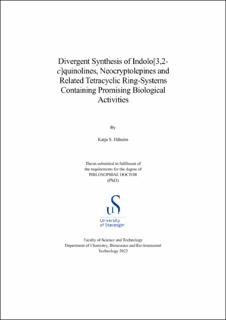| dc.description.abstract | Malaria is a devastating tropical disease, claiming approximately 627 000 lives in 2020. Due to the appearance of resistance towards artemisinin-based therapies, the discovery of novel treatments are of paramount importance. The indoloquinoline natural products cryptolepine, neocryptolepine and isocryptolepine, first discovered in the extracts of the African bush plant Cryptolepis sanguinolenta, have been found to exhibit potent antimalarial properties. More-over, several functionalized derivatives of these compounds have shown great promise as antiplasmodial agents. The indoloquinoline alkaloids have also been found to possess significant antiproliferative and antimicrobial properties, making them ideal targets for the development into novel drug candidates.
The first project in this work details the application of a synthetic approach first developed by Helgeland and Sydnes to assemble various tetracyclic ring systems. The key synthetic strategies being a Suzuki-Miyaura cross-coupling reaction followed by a palladium-catalyzed intramolecular cyclization. Though the approach was unsuitable to construct all the intended target molecules, it furnished the unexpected pyridophenanthridine scaffold. By further investigating alternative protocols for the construction of indoloquinolines, a regiodivergent intermediate was discovered, which allowed for the synthesis of both novel pyridophenanthridineand pyridocarbazole scaffolds by utilizing two different reaction protocols. By subjecting this common intermediate to a diazotization-azidation-nitrene insertion approach, the novel pyrido-carbazoles could be furnished in excellent yields.
The unexpected formation of a biquinoline bridged by an aniline during a Suzuki-Miyaura cross-coupling reaction, was deemed interesting for development into a transition metal complex for catalysis. Through a collaborative effort with Dr. Eugene Khaskin’s group at Okinawa Institute of Science and Technology, five quinoline/pyridine N,N,N ligands were designed and synthesized. The key synthetic tools utilized in their construction was either a sequential Suzuki-Miyaura cross-coupling reaction and Buchwald-Hartwig amination or reductive amination.
A novel two-step approach for the synthesis of the natural product neocryptolepine from commercially available bromoquinolines was developed. The key transformations being regioselective N-alkylations followed by a cascade Suzuki-Miyaura cross-coupling reaction andintramolecular nucleophilic C-N bond formation. The scope and limitations for the novel protocol was evaluated through the preparation of 24 neocryptolepine derivatives, bearing a diverse range of functional groups, where electron-withdrawing group substitutions were generally superior.
It became apparent that it would also be possible to prepare a library of indolo[3,2-c]quino-lines from the same starting material as the newly devised strategy to produce neocryptolepines. By utilizing a reaction sequence consisting of a Suzuki-Miyaura cross-coupling reaction, installation of an azido moiety and finally photochemical cyclization, this goal was realized, producing a total of 19 indoloquinolines. This protocol was less robost towards substrate functionalizations than the neocryptolepine approach, with no apparent trend concerning electron-withdrawing and electron-donating groups being apparent. The photochemical cyclization was hypothesized to proceed via the formation of a reactive singlet nitrene intermediate. Finally, a selection of the prepared tetracyclic compounds assembled during this work was evaluated for their antiplasmodial, antiproliferative and antimicrobial activities by the help of various external collaborators. The most successful compound was revealed to be the novel pyridophenanthridines, displaying more potent antiproliferative activities than doxoru-bicin against human prostate cancer (IC50= 24 nM). The novel pyridocarbazoles moreover showed excellent inhibition of biofilm formation, with the potential to be developed into a dualanticancer-antimicrobial agent. Of all the tested compounds, only N-methylated pyridocar-bazole was found to contain any significant activity against the evaluated Plasmodium falci-parumstrain. The antimicrobial assays revealed the importance of the inclusion of a methylgroup for activity, but not strictly in the form of an N-methyl unit, which is the general concensus in the literature thus far. Further, chlorinated indoloquinolines were revealed to contain excellent antimicrobial activity against both Gram-positive and Gram-negative bacterial celllines. | en_US |
